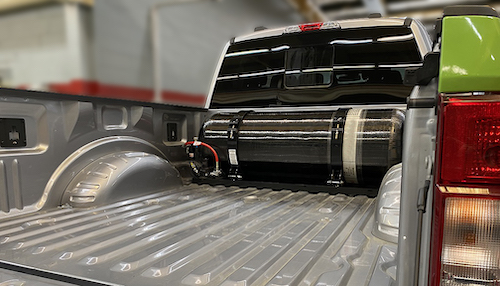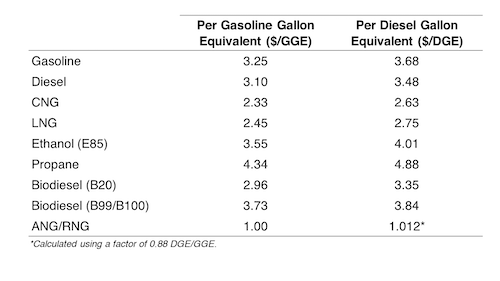Adsorbed Natural Gas (ANG)
Natural gas is a gaseous fuel and requires large pressures for compression for delivery and storage. This large compression pressure requirement translates to bulky, heavy, and costly1 equipment,which could hamper the investment of private sectors in natural gas as transportation fuel.
Adsorption technology presents a promising solution to these issues. Adsorption storage is retaining gas inside a porous adsorbent – the most common of which is activated carbon due its porosity, wide availability, and low production cost. This technology allows storage of natural gas at higher density at pressures that are significantly less (500 – 900 psi) than compression needed for CNG (3600 psi). This is known as the Adsorbed Natural Gas (ANG) technology. 2,3
Ingevity, the company that developed Nuchar® – a world leading solution to automotive evaporative emission using activated carbon, also developed an ANG technology that is currently used in transportation. Ingevity manufactures activated carbon bed contained in a cylindrical tank and is specifically designed for ANG storage. This uses the same adsorption principle used to condense vapor emissions in gasoline tanks4 and saves the atmosphere from thousands of gallons of fossil fuel vapor pollutant annually. The 18in x 60in tank is nested in the bed of trucks as shown in the image below. The tank can hold about 6 gasoline gallon equivalent (GGE) and can be drawn to almost empty. The upfit converts the truck into a bi-fuel set-up and allows it to seamlessly switch between gasoline and natural gas while running.

Image source: http://www.transecoenergy.com/Pages/ANG-6.2L-page.html
Gaseous Engine Prep
Compared to gasoline, gaseous fuels have lower lubricating characteristics and higher combustion temperatures. To prevent abnormal engine wear, when running on gaseous fuels, auto manufacturers offer “prep ready” vehicles with gaseous engine prep package. The package includes hardened engine intake and exhaust valves, valve seats, and high-temperature tolerant materials and helps prevent engine damage from the low lubricity and high combustion temperatures of gaseous fuels.5 Bi-fuel engines, on the other hand, can benefit from the lubrication provided by gasoline in prolonging the life of the valves and seals. This can be achieved when the natural gas system is designed to force gasoline injections at certain intervals.6 Engine calibrations can also be modified to mitigate risk of damage.
ANG-RNG Platform: Am I supporting fossil gas by using ANG-RNG?
Users of Ingevity's ANG vehicles can take advantage of Ingevity's partnership with GreenGasUSA, a company that produces RNG through capturing methane from agricultural and municipal wastes. Through this partnership, Ingevity offets the fossil natural gas usage of its own ANG fleet with RNG and can also do so for the users of the ANG vehicles who choose to participate. Thus, users of the ANG vehicle could support the displacement of fossil natural gas with its RNG in the pipelines.
Another possible avenue for natural gas vehicle users to participate in the RNG market is through the government's Renewable Fuel Standard (RFS) program though this route has not been fully implemented yet in the ANG platform. In 2007, the US congress created the Renewable Fuel Standard program to incentivize parties involved in producing, distributing, and utilizing RNG. Under the RFS program of the US EPA, RINs were introduced to track the production and use of renewable fuels. The creation of RINs allowed the “obligated parties” (refiners or importers of gasoline or diesel fuel) to choose whether to purchase renewable fuels for direct blending or purchase RINs in the spot market as a way for fulfilling their obligations under the RFS program. RINs therefore can be viewed as a transfer payment from obligated parties to renewable fuel blenders to encourage the use of blending of renewable fuels and the sale of fuels with high percentage blend of renewable fuels. This can translate to a higher demand in renewable fuels.7 In California, it is expected that by the end of the fourth of quarter of 2020, RNG already comprises 95% of the state’s total CNG volume as reported under its LCFS program.8 It is expected that, by early 2024, RNG will completely saturate the national NGV fuel market.9
How am I supporting the local economy in using RNG?
RNG is produced using locally available resources such as landfills, animal wastes, and industrial wastewater and organic waste. With the financial incentives available through federal and state governments, the use of RNG benefits the economy by driving project developments such as construction of RNG processing and fueling station infrastructure and sale of natural gas-powered vehicles.10 RNG Coalition, a non-profit organization dedicated to the advancement of renewable natural gas, estimates RNG to contribute 22,600 jobs in and $2.6B from both existing and under construction facilities. By 2050, if the goal of 43,000 RNG facilities is met, 6,528,938 additional jobs will have been created.11
How much is the cost of ANG-RNG vehicle and what is the payback period?
To upfit a Ford F-250 with the ANG-RNG technology would cost $10,000 more than a regular brand-new F-250 and the refueling appliance costs $5000. With the price differential in fuel (vs regular gasoline), the expected annual savings is at $2 per gallon, or about $2700.00 per truck per year. With this estimated savings, payback period is calculated at 5.5 years for one truck and 4.5 years for two trucks. With incentives from various government programs, it can further go down to 4 years.
How does the ANG-RNG vehicle compare to other fuel types in terms of fuel cost?
The following table shows the average retail prices of fuels as of October 2021 as reported by US Department of Energy12:

1 Costs Associated With Compressed Natural Gas Vehicle Fueling Infrastructure. (n.d.). US Department of Energy. p.12. Available online at https://www.nrel.gov/docs/fy14osti/62421.pdf accessed on 01 March 2022.
3 Dziewiecky, M. (2018). Adsorbed Natural Gas Tan feeded with Liquid Natural Gas. E3S Web of Conferences, 44, 00038. doi:10.1051/20184400038
5 Kelly, K. and Gonzales, J. (n.d.). What Fleets Need to Know About Alternative Fuel Vehicle Conversions, Retrofits, and Repowers. National Renewable Energy Laboratory, retrieved from https://afdc.energy.gov/files/u/publication/afv_conversions_retrofits_repowers.pdf
6 Erikkson, J. & Wallengren, Mårten. (2013). Model Based Control Algorithm for a Bi-fuel Engine with fuel adjustment. Digitala Vetenskapliga Arkivet. Available online at https://www.diva-portal.org/smash/get/diva2:695509/FULLTEXT01.pdf accessed on 01 April 2022.
8 Low Carbon Fuel Standard Reporting Tool Quarterly Summaries. (2021, October 29). California Air Resources Board. https://ww3.arb.ca.gov/fuels/lcfs/lrtqsummaries.htm
9 Gladstein, Neandross & Associates (GNA). (2021, May). State of Sustainable Fleets 2021 Market and Trends Brief. 18-22. Santa Monica, CA. retrieved from www.StateofSustainableFleets.com
10 Renewable Natural Gas. (n.d.) United States Environmental Protection Agency. https://www.epa.gov/lmop/renewable-natural-gas#benefits
11 RNG Coalition. (2021). Economic Analysis of the US Renewable Natural Gas Industry. Retrieved from https://www.rngcoalition.com/data-resources-2
12 US Department of Energy. (2021, October). Clean Cities Alternative Fuel Price Report. p4. https://afdc.energy.gov/files/u/publication/alternative_fuel_price_report_october_2021.pdf
